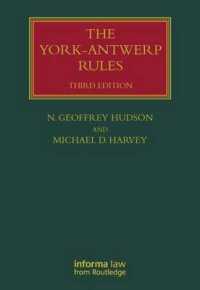Full Description
Taking a macrosociological, global approach, Human Societies offers an introduction to sociology that is truly comparative, cross-cultural, and historical. It compares societies over time and across environments, emphasizing the dynamics of social change. Its clearly developed ecological-evolutionary perspective provides a powerful theoretical framework for understanding the array of social arrangements found in human societies over the past 100,000 years. Since industrial societies are introduced only after this theoretical base has been firmly established and older, simpler, and smaller societies have been examined in detail, students see their own society (and other contemporary societies) in a broader and more meaningful way. By showing how social arrangements are related to the environmental and technological contexts that societies are situated in, Human Societies encourages students to look for the reasons why social arrangements are the way they are, and why they change over time.
Contents
Preface
Part One: Theoretical Foundations
1. The Human Condition
Human Societies: Their Place in Nature
Societies as Adaptive Mechanisms / A Definition of Human Societies
Understanding Human Societies: Basic Assumptions
Human Societies and the Environment / Human Societies: Their Genetic Heritage / Human Cultures: A New and Unique Mode of Adaptation and a New and Unique Kind of Heritage
Human Societies: The Basic Model
Excursus: A Brief History of Sociology
2. Human Societies as Sociocultural Systems
Human Societies as Systems
The Five Basic Components of Human Societies
Population / Culture / Material Products / Social Organization / Social Institutions and Institutional Systems
The World System of Societies
3. The Evolution of Human Societies
Forces Promoting Social and Cultural Continuity
Forces Promoting Social and Cultural Change
Forms of Innovation / Causes of Innovation / Variations in the Rate of Innovation
Forces of Selection
Intrasocietal Selection / Intersocietal Selection
Societal Growth and Development
Subsistence Technology's Role in Sociocultural Evolution / Ideology's Role in Sociocultural Evolution
A Model of the Evolution of the World System of Societies
Excursus: A Comparison of Biological and Sociocultural Evolution
4. Types of Human Societies
Classifying Human Societies
Societal Types through History
Historical Eras
Differences among Types of Societies
Size of Societies / Permanence of Settlements / Societal Complexity / Ideology
Societal Types: What They Are and What They Are Not
Technological Determinism Rejected
Part Two: Preindustrial Societies
5. Hunting and Gathering Societies
The Emergence of Homo Sapiens prior to 100,000 BC: Establishing a Genetic Foundation for Cultural Evolution
Hunting and Gathering Societies 100,000 BC to 8,000 BC: Cultural Evolution Takes
Hunting and Gathering Societies of the Recent Past
Population / Kinship / The Economy / The Polity / Stratification / Religion / Education / The Arts and Leisure / Tribal Ties: Links between Societies
Hunting and Gathering Societies in Theoretical Perspective
Archaeological and Ethnographic Evidence Compared / A Model of Limited Development / The Last Hunting and Gathering Societies
6. Horticultural Societies
Causes of the Shift from Hunting and Gathering to Horticulture
The Technology of Horticulture
Simple Horticultural Societies in Prehistoric Asia and Europe
The First Great Social Revolution
Simple Horticultural Societies in the Modern Era
Population and Economy / The Continuing Importance of Kinship / Developments in Polity, Stratification, and Warfare
Advanced Horticultural Societies in Prehistoric Asia and Europe
The Shift from Stone to Metals / Social Consequences of Metal Tools and Weapons
Advanced Horticultural Societies in the Modern Era
Increased Size and Complexity / Political Development / Horticultural Societies in Southeast Asia
Horticultural Societies in Theoretical Perspective
Excursus: Race, Environment, and Societal Development
7. Agrarian Societies
Simple Agrarian Societies
Technology / Religion and the Growth of the Economic Surplus / Population: Growth in Size of Communities and Societies / The Polity: Growth of the State / The Economy: The First Monetary Systems and the Growth of Trade / Stratification: Increasing Inequality / Slowdown in the Rate of Technological Innovation
Advanced Agrarian Societies
Technology / Population: Continuing Trends / The Economy: Increasing Differentiation / The Polity: Continuing Development of the State / Religion: The Emergence of Universal Faiths / Kinship: Changing Significance in Society / The Role of Women in Agrarian Societies / Leisure and the Arts / Stratification: Increasing Complexity
Variations on Agrarian Themes
Agrarian Societies in Theoretical Perspective
8. Some Evolutionary Bypaths and a Brief Review
Environmentally Specialized Societal Types
Fishing Societies / Herding Societies / Maritime Societies
A Brief Review: Sociocultural Evolution to the Eve of the Industrial Revolution
Part Three: Industrial Societies and Industrializing Societies
9. The Industrial Revolution
Causes of the Industrial Revolution
The Accumulation of Information in the Agrarian Era / Advances in Water Transportation and the Conquest of the New World / The Printing Press and the Spread of Information / Advances in Agriculture / A Model of the Causes of the Industrial Revolution
A Brief History of the Industrial Revolution
First Phase: Steam Engines, Iron, Coal, Textile Machines, Factories / Second Phase: Railroads, Steamships, Steel, Rubber, Farm Machines / Third Phase: Automobiles, Airplanes, Telephones, Electricity, Petroleum, Radios, Movies / Fourth Phase: Television, Computers, Transistors, the Internet, Plastics, Globalization / Key Innovations: New Energy, New Machines, New Materials / A Caution: The Dark Side of the Industrial Revolution
Causes of the Continuing Industrial Revolution
Greater Informational Resources and a Larger Population / Changing Attitudes toward Innovation / The Rise of Modern Science / War / Environmental Feedback / The Desire for Ever Higher Standards of Living
Varying Levels of Industrialization in the World System of Societies?
Consequences of the Industrial Revolution
Initial Consequences / Long-Run Consequences: An Overview
10. Industrial Societies: Technologies and Economies
The Technological Foundation of Industrial Societies?
The Economies of Industrial Societies
The Urbanization of Production / Rise in Productivity and in the Standard of Living / The Shift from Labor-Intensive to Capital-Intensive Industries / Changes in the Labor Force / The Rise of Market Economies / Moves toward Mixed Economies / Evolution of the Modern Corporation
Globalization: Increasing Economic Integration of the World Economy
11. Industrial Societies: Ideologies and Polities
Ideologies in Industrial Societies
Theistic Religions / New Secular Ideologies
Differences among Industrial Societies
The Polities of Industrial Societies?
The Democratic Trend / Democracy as a Variable / Causes of the Democratic Trend / Mass Political Parties / Special Interest Groups / The Mass Media / Political Conflict and Stability / The Growth of Government / Governmental Bureaucracies: Their Expansion and Transformation
Political Globalization and the Challenge to the New World Order?
12. Industrial Societies: Social Stratification
Stratification in Industrial Societies
Political Stratification / The Distribution of Income / The Distribution of Wealth / Occupational Stratification / Educational Stratification / Racial and Ethnic Stratification / Age and Sex Stratification
Vertical Mobility
Social Inequality: Two Basic Trends
13. Industrial Societies: Population, the Family, and Leisure
Population
Growth in Size of Societies / Trends in Health and Longevity / Declining Birthrates and Increasing Immigration / Population Distribution: The Growth of Urban Populations
The Family
Changing Structure of Households and Families/ Changing Functions of the Family / Causes of Change in the Family / The Nuclear Family in Industrial Societies / The Changing Role of Women / The Changing Role of Youth /The Generation Gap
Leisure and the Arts
Problems and Progress
Industrial Societies in Theoretical Perspective
14. Industrializing Hybrid Societies
Two Types of Industrializing Societies
Economies and Population Growth
Ideologies
Polities and Conflicts
Social Stratification
Education
Kinship
The Status of Women
Industrializing Societies in Theoretical Perspective
Excursus: Marxist Societies as Natural Experiments
15. Retrospect and Prospect
Looking Back
The Divergent Path / The Question of Progress
Looking Ahead
Population / Natural Resources and the Biophysical Environment / Technology / Ideology / Polity / Economy / The World System / The Higher Goals
Glossary
Appendix
Notes
Photo and Art Credits
Index
About the Authors
Index







